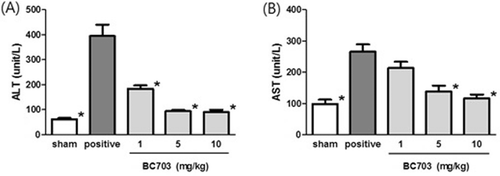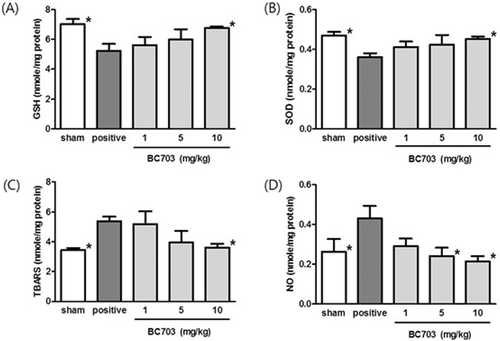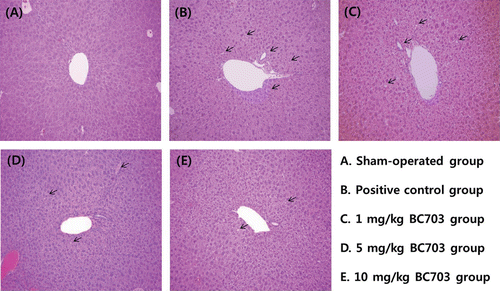Figures & data
Figure 1. Representative HPLC chromatograms of triterpenoids in BC703. The numbers indicate each platycoside: 1, deapio-platycoside E; 2, platycoside E; 3, platycodin D3; 4, deapio-platycodin D; 5, platycodin D; 6, 3″-O-acetyl platycodin D; 7, polygalacin D; 8, 2″-O-acetyl platycodin D; 9, an unknown compound.

Figure 2. Effect of BC703 on liver function in the bile duct ligation (BDL)-induced acute hepatic injury. Mice were given orally BC703 (0, 1, 5, and 10 mg/kg) once daily for 3 consecutive days prior to BDL. Values are expressed as means ± standard error (SEM). *p < 0.05, a significant difference in comparison with the positive control group.

Figure 3. Effect of BC703 on the hepatic GSH (A), SOD (B), lipid peroxidation (C) and NO (D) content in the bile duct ligation (BDL)-induced acute hepatic injury. Mice were given orally BC703 (0, 1, 5, and 10 mg/kg) once daily for 3 consecutive days prior to BDL. Values are expressed as means ± standard error (SEM). *p < 0.05, a significant difference in comparison with the positive control group.

Figure 4. Histopathological changes of the liver stained with hematoxyline and eosin on the bile duct ligation (BDL)-induced liver injury (×100). Mice were given orally BC703 (0, 1, 5, and 10 mg/kg) once daily for 3 consecutive days prior to BDL. (A) nontreated sham-operated group; (B) nontreated BDL group; (C) BC703 (1 mg/kg) treated BDL group; (D) BC703 (5 mg/kg) treated BDL group; (E) BC703 (10 mg/kg) treated BDL group. Arrows indicate the bile duct proliferation and hepatocyte necrosis.
